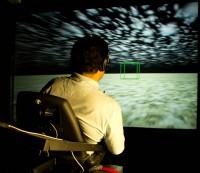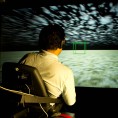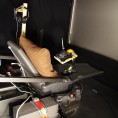
Can self-motion perception in virtual reality (VR) be enhanced by providing affordable, user-powered minimal motion cueing?
Introduction & Motivation: Can self-motion perception in virtual reality (VR) be enhanced by providing affordable, user-powered minimal motion cueing? To investigate this, we compared the effect of different interaction and motion paradigms on onset latency and intensity of self-motion illusions (“vection”) induced by curvilinear locomotion in projection– based VR.
Methods: Participants either passively observed the simulation or had to actively follow pre-defined trajectories of different curvature in a simple virtual scene. Visual-only locomotion (either passive or with joystick control) was compared to locomotion controlled by a modified Gyroxus gaming chair, where leaning forwards and sideways (±10cm) controlled simulated translations and rotations, respectively, using a velocity control paradigm similar to a joystick. In the active visual+chair motion condition, participants controlled the chair motion and resulting virtual locomotion themselves, with– out the need for external actuation. In the passive visual+chair motion condition, the experimenter did this.
Results & Discussion: Self-motion intensity was increased in the visual+chair motion conditions as compared visual-only motion, corroborating the benefit of simple motion cueing. Surprisingly, however, active control reduced the occurrence of vection and increased vection onset latencies, especially in the chair motion condition. This might be related to the reduced intuitiveness and controllability observed for the active chair motion as compared to the joystick condition.
Conclusions: Together, findings suggest that simple user-initiated motion cueing can in principle provide an affordable means of increasing self-motion simulation fidelity in VR. However, usability and controllability issues of the gaming chair used might have counteracted the benefit of such motion cueing, and suggests ways to improve the interaction paradigm.
Video of how such motion cueing could be applied in VR simulations
Below is an example of how one can control the self-motion simulated in Virtual Reality by simply leaning into the direction of intended travel. No motors, actuators, or complex motion cueing algorithms needed.

Videos of the four motion conditions
"Visual+Chair Active" condition: Participant actively controls locomotion using Gyroxus gaming chair

"Visual+Chair Passive" condition: Experimenter controls locomotion using Gyroxus gaming chair

"Visual-only Active" condition: Participant actively controls locomotion using Joystick

"Visual-only Passive" condition: Participant simply watches simulated motions without any control


